Hybrid watermelon "Karistan" with large and sweet fruits
More recently, it was believed that watermelons are a very capricious and thermophilic berry. They were grown only in the southern regions. For residents of other localities, the chances of waiting for the fruit to ripen were close to zero. Everything changed with the development of new hardy varieties and hybrids. Among them is the cold-resistant watermelon Karistan, which yields a crop in almost every corner of our country.
The content of the article
Description of watermelon
This early ripening hybrid was bred by Dutch specialists just a couple of decades ago. In Russia, Karistan began to be tested in 2007, and since 2012 it was officially allowed for cultivation in open ground in the Volga region, in the Urals and in other areas.
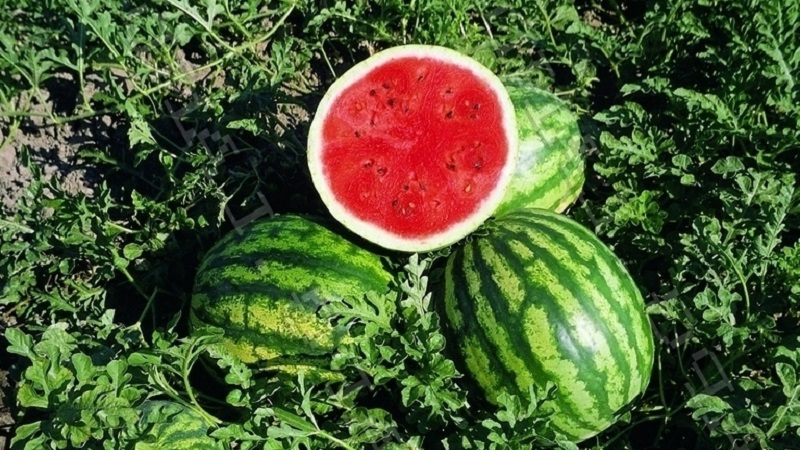
The flesh of the fruit is unusually sweet and juicy. The early maturity of the hybrid eliminates the use of fertilizers containing nitrates and other chemical compounds that are unsafe for health.
Suitable for Karistan f1 for industrial cultivationand for personal use.
Distinctive features
Features of the hybrid:
- oblong fruits of elongated elliptical shape with juicy pulp, unusually sweet taste for those grown in the middle lane;
- the fruits have time to ripen 65–70 days after the seeds are planted in the ground;
- Karistan tolerates cool summers well, unlike other varieties.
The last two properties make it possible to grow watermelons in areas with short and cool summers. without using greenhouses.
Composition and properties
Despite its sweetness, watermelon is low in calories (27 kcal per 100 g), therefore it is included in dietary diets.
Nutritional value of pulp per 100 g:
- proteins - 0.7;
- fats - 0.1;
- carbohydrates - 5.8;
- dietary fiber - 0.4;
- water - 93.
Fruits are rich in vitamins A, C, group B and minerals (potassium, sodium, magnesium, phosphorus, calcium).
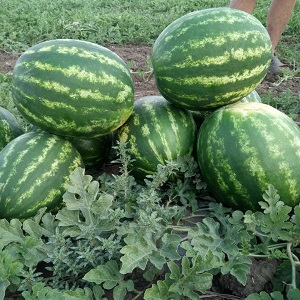 The benefits of watermelon:
The benefits of watermelon:
- normalizes the nervous system;
- improves brain activity, memory;
- normalizes heart rate;
- has diuretic and laxative effects;
- restores the body's water balance, eliminates dehydration;
- fights high cholesterol;
- removes toxins;
- used in home cosmetology for skin care.
The main harm to the body is brought by watermelons treated with chemical fertilizers and containing nitrates. It is they who cause the poisoning. The use of juicy berries is limited for diabetes, urolithiasis, problems with the gastrointestinal tract and for children under 3 years old.
About other varieties and hybrids of watermelon:
Popular watermelon "Crimson Sweet": pros, cons and cultivation
Specifications
Fruit shape is oval or oblong... The berries are large or medium in size, with a thin to medium green bark, medium stripes, light to dark green. The average weight of fruits is from 3 to 5 kg, but according to the information of the originator - up to 16 kg.
The flesh is unusually firm, juicy and crunchy, red and even dark red. Sweet, sugary to taste (6-8% sugars).
Bushes are strongly elongated, with thick strong lashes. Leaves are slightly dissected, green, medium in size. Protect fruits from the scorching sun.
High-yielding hybrid... When grown in the field without additional irrigation, 150–250 c / ha are harvested. With drip irrigation and regular feeding, productivity increases.
Seeds of watermelon
Seeds of Karistan small black... They ripen well in fruits, but are unsuitable for further planting: the qualities of the hybrid will not be preserved in the next generation.
The producer himself processes the grain with a special solution (“Tiram”) for the resistance of the culture to fusarium and anthracnose. The product colors the seeds in a rich red hue.
How to grow yourself
Cultivating Karistan is easy: he is unpretentious in care. Plants are planted both in open ground and in hotbeds and greenhouses. To accelerate the ripening time, the seedling method is used. Plants that are immediately sown in open ground take root best of all, but this is impossible in the northern regions.
Step-by-step cultivation and care
Stage one - seed preparation... They are germinated in moist gauze until shoots appear and must be warmed up at + 50 ... + 55 ° C. Then they are laid out in containers with a pre-mixed peat-humus soil, sprinkled with light soil. Sowing depth is 3-5 cm.
 The container is placed on the windowsills under the rays of the sun, and on top is additionally covered with foil or glass. After the emergence of sprouts, the temperature is lowered to + 20 ° C, and then to + 15 ° C, watch out for a sufficient amount of sunlight.
The container is placed on the windowsills under the rays of the sun, and on top is additionally covered with foil or glass. After the emergence of sprouts, the temperature is lowered to + 20 ° C, and then to + 15 ° C, watch out for a sufficient amount of sunlight.
Seedlings dive into the ground a month later in well-heated beds. Seedlings do not keep in containers longer than this period: the root system is already ready for new conditions. If the weather does not allow planting the crop in open ground, additional insulation from covering materials is equipped. The optimum temperature for the growth of watermelon is not lower than + 20 ° C.
Bushes are placed at a sufficient distance from each other (preferably after 1 m2) so that the roots get enough nutrients, moisture and oxygen.
In warm regions, sowing in open ground is carried out in May, when the soil warms up to + 12 ... + 15 ° C. The seeds are deepened by 8-10 cm (with drip irrigation - by 1-3 cm), maintained at intervals of 0.6-1 m.
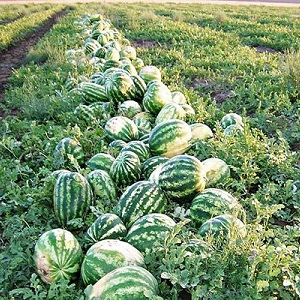 Water the culture 1-2 times a week, in the evening... At the flowering stage, this is done less often, and when fruiting, they stop. For the entire season, 2 dressings are applied: after picking the seedlings into open ground, use a mullein solution (1:10), after 15 days - ammonium nitrate (20 g per 10 l of water).
Water the culture 1-2 times a week, in the evening... At the flowering stage, this is done less often, and when fruiting, they stop. For the entire season, 2 dressings are applied: after picking the seedlings into open ground, use a mullein solution (1:10), after 15 days - ammonium nitrate (20 g per 10 l of water).
The soil is regularly loosened, weeded... The excess lashes are pinched, the main stem is left. After the formation of 2-3 watermelons, the central shoot is also pinched.
Important! To evenly warm up and prevent the fruit from arguing, they are periodically turned over from one side to the other.
Features of cultivation and possible difficulties
Necessary conditions for obtaining a rich harvest Karistan:
- good illumination, especially when growing seedlings;
- compliance with the temperature regime and the use of covering material;
- abundant humidity - the volume of the crop directly depends on it;
- fertility of the soil, but without the abuse of chemicals.
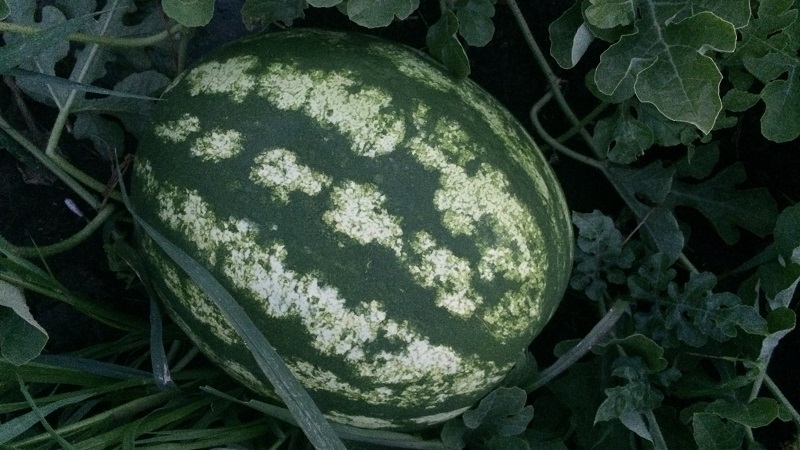
Diseases and pests
Caristan is prone to fungal diseases... This is facilitated by low temperatures, cloudy weather, rains, and dampness.
The most common hybrid diseases:
- powdery mildew;
- olive spot;
- blackleg.
For the prevention and control of them, such methods are used.:
- control humidity without flooding the plants;
- often weed and loosen the soil;
- follow the rules of crop rotation;
- remove the affected parts of the bushes;
- treat the bushes with biological products.
Of the pests, the danger to watermelons is:
- aphid;
- sprout fly.
They use insecticides, ash infusion.
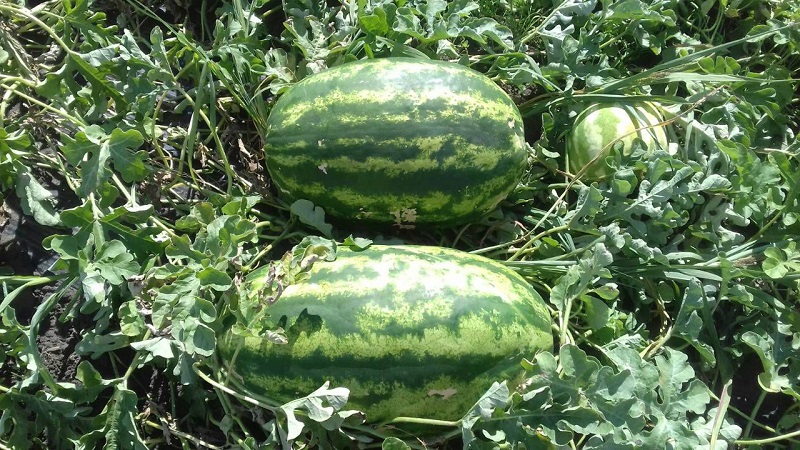
Harvesting and application of the crop
The crop is harvested in clear sunny weather, not earlier than 4-5 days after rain... This will preserve the fruits longer, allow them to be transported over remote distances.
The readiness of watermelons for collection is determined by:
- dried stalk;
- yellow spot;
- increased hardness of the crust.
The fruits are consumed fresh, prepared from them jam, candied fruits, fruit juices and smoothies, various exotic snacks.
Read also:
Advantages and disadvantages
Hybrid advantages:
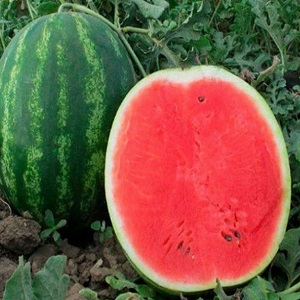 high yield for any planting method;
high yield for any planting method;- sugar-sweet pulp taste;
- high germination of seeds, uniform ripening of fruits;
- resistance to cold snaps, sunburn;
- long-term storage;
- high portability;
- excellent presentation.
disadvantages:
- a decrease in the sweetness of watermelons during prolonged cloudy weather;
- lack of seedlings when planting in cold soil.
Reviews
Farmers note the excellent taste of the fruit, the unpretentiousness of the crop and the high yield:
Alexey, Krasnodar region: “We grow Karistan from seedlings using irrigation systems. The hybrid showed itself well: fruitful, transportable, with excellent fruit taste and small seeds. We cultivate for sale, we get a good profit from it ".
Veronica Moscow region: “I planted Karistan in a greenhouse - it took root well, despite the fact that May was cool. We got several watermelons from one bush. The weight of the largest is about 4 kg. It tastes sweet, not at all like purchased watermelons ".
Conclusion
Watermelon Karistan is a godsend for the Urals, Siberia and Central Russia. The hybrid is unpretentious in care, gives a rich harvest in greenhouses and in the open air. Additional protection under the covering material, abundant watering and several dressings per season will increase the productivity of the crop. Delicious berries are used fresh, and various snacks are prepared from them.